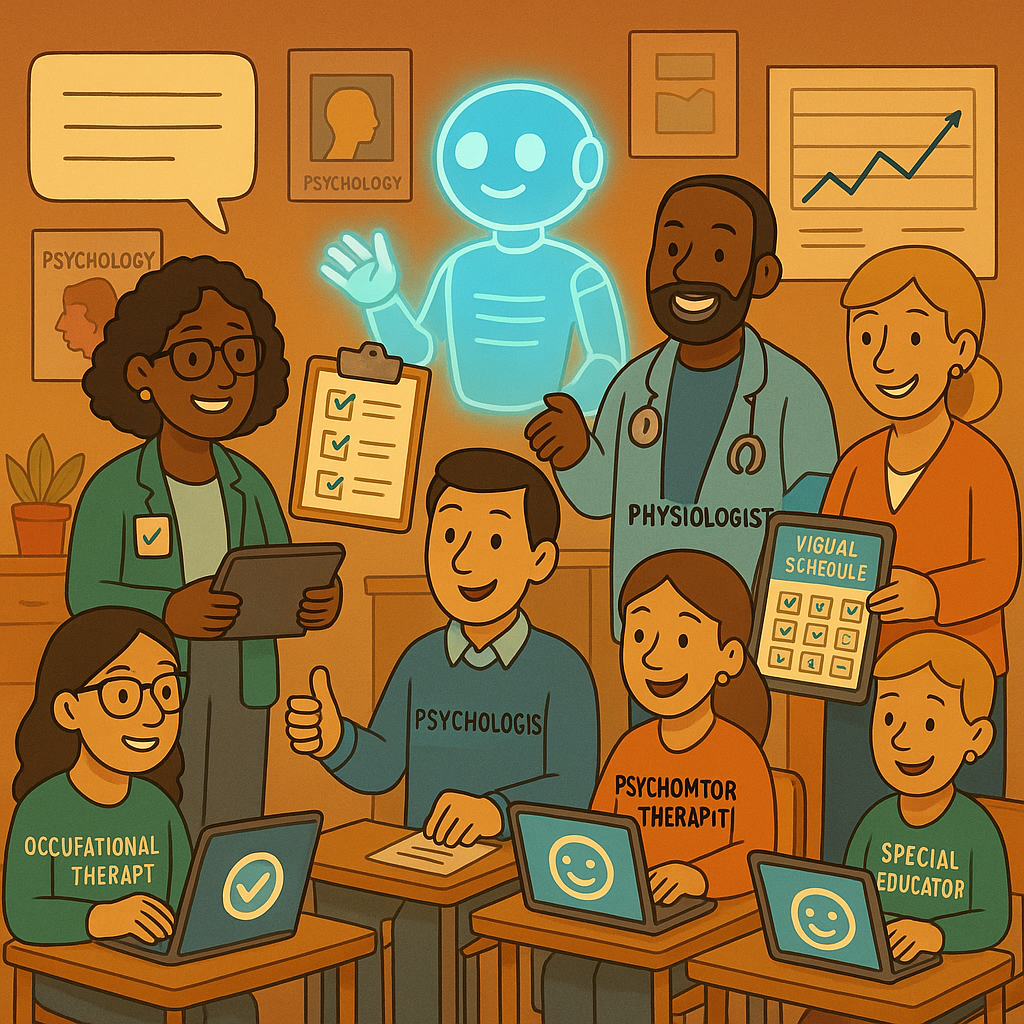
In 2025, therapist burnout is no longer a background issue—it’s front and center. Long hours, rising caseloads, and growing documentation demands have left professionals across disciplines struggling to maintain balance. Whether in schools, clinics, hospitals, or home settings, many therapists find themselves spending more time on paperwork and planning than on actual client care.
This growing administrative load impacts not only therapists’ well-being but also the consistency and quality of support clients receive. Fortunately, artificial intelligence (AI) is beginning to offer real relief. When thoughtfully integrated, AI tools can streamline the most time-consuming tasks—freeing therapists to focus on what truly matters: connection, intervention, and outcomes.
Below are three AI tools making a measurable difference, with examples that apply across settings and disciplines.
1. SLPToolkit’s Smart Goals Generator: Faster, Focused IEP Writing
Writing individualized, measurable goals is a cornerstone of therapy—but also one of the most repetitive and draining parts of the job. SLPToolkit’s Smart Goals Generator uses AI to suggest developmentally appropriate, goal-aligned statements based on client needs and clinical input.
Instead of starting from scratch, therapists receive a structured goal template that can be quickly customized and approved. This not only saves time but also ensures that goals remain SMART—Specific, Measurable, Achievable, Relevant, and Time-bound.
“Before using this tool, I would spend hours writing goals for each client. Now, I start with a clear draft and spend my energy personalizing, not formatting.”
General Applications Across Roles:
- School-based professionals use it to draft IEP goals aligned with classroom accommodations and therapy targets.
- Clinic-based therapists adapt goal templates for early intervention or rehabilitation clients.
- Teams working across disciplines can ensure consistency in how goals are written and tracked across speech, motor, and cognitive domains.
2. ChatGPT for SOAP Notes: Structured Documentation in Minutes
Clinical documentation is essential—but often exhausting. Writing clear, structured SOAP notes (Subjective, Objective, Assessment, Plan) can take up a major portion of a therapist’s day, especially when working with back-to-back sessions.
ChatGPT can help by transforming quick session summaries or bullet-point notes into well-structured clinical documentation. Therapists input short, factual descriptions of what occurred during the session, and the AI generates a draft that can be reviewed, edited, and saved.
“It’s like having a reliable first-draft assistant. I still edit, but I no longer start from a blank page.”
General Applications Across Roles:
- Professionals in schools, hospitals, or private clinics use it to document progress, prepare reports, or meet insurance requirements.
- Those supporting multiple clients per day find it particularly helpful for cutting down documentation time while maintaining quality.
- Teams using shared documentation platforms can use AI to ensure consistency and professional tone across providers.
3. Eduaide.ai and Curipod: Efficient Session Planning and Communication
Planning engaging, evidence-based sessions is essential—but takes time many professionals don’t have. Eduaide.ai and Curipod help generate developmentally appropriate activities, visual supports, and even handouts for parents or caregivers.
With Eduaide.ai, therapists simply input a skill or goal (e.g., “working memory in school-aged children”) and receive structured session plans with differentiated activities and visuals. Curipod takes this further by offering editable slide decks, quizzes, and interactive prompts perfect for group work or psychoeducation.
“What used to take me two hours to prep now takes thirty minutes—and the quality is actually better.”
General Applications Across Roles:
- School therapists and educators use these tools to plan weekly themes or social-emotional learning (SEL) lessons.
- Clinic-based professionals use them to create visuals, games, and structured routines tailored to client goals.
- Family-centered therapists use the tools to create handouts or home practice materials, improving carryover and collaboration.
Why These Tools Matter Across Disciplines
AI isn’t just for tech-savvy professionals—it’s becoming a vital support across therapy and education. Whether you’re writing behavior goals, documenting a sensory-motor session, or planning a group intervention, these tools offer:
- Time savings on routine yet essential tasks
- Consistent quality across notes, goals, and materials
- Greater flexibility for individualized care
- Improved collaboration across multidisciplinary teams
Most importantly, they allow therapists to spend more time in real therapeutic work and less time buried in administrative tasks.
Final Thoughts: Reclaiming Time for What Matters Most
AI will never replace the empathy, expertise, or relational power of a therapist. But it can serve as a quiet co-pilot—handling the repetitive groundwork so clinicians can focus on high-impact work.
Whether you’re working in early intervention, school-based support, outpatient rehab, or mental health—these tools are designed to reduce overload, not add to it. As burnout becomes an increasingly common reality in helping professions, AI may offer part of the solution: a way to reclaim time, increase precision, and bring balance back into our work.
Recommended Tools
